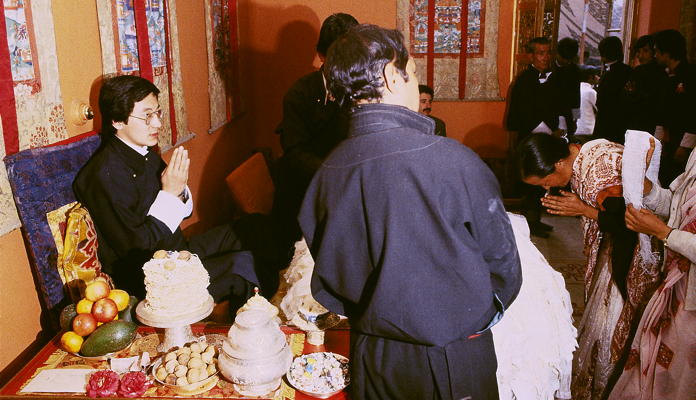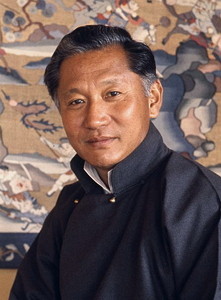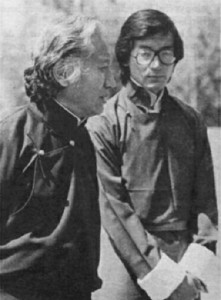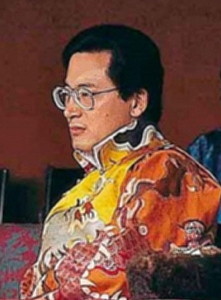
Denjong Chogyal
According to traditional lore, the Buddhist Kingdom of Sikkim was formally established in 1642 by the saints Namkha Jigme Kunzang Namgyal, Kathog Kuntu Zangpo and Ngadag Sempa Phuntsog Rigdzin at Yuksam conforming to a prophecy of Guru Rinpoche from the 8th century. They consecrated Prince Puntshog, a descendant of Khye Bumsa, as the first Denjong Chogyal and thus founded the House of Namgyal as the royal dynasty of Sikkim. According to Buddhist tradition, the name 'Namgyal' was passed from the master (Lhatsun Namkha Jigme) to his disciple (Prince Puntshog).
Denjong as a variably sovereign kingdom was to last for 333 years, but the tradition of the Chogyal did require neither subjects nor a territory to survive. The title 'Chogyal' (Dharmaraja) includes temporal as well as spiritual power and leadership, the 8th, the 10th and the 12th Chogyal of Sikkim were even Tulkus, recognised reincarnations of a Buddhist master from Kham Dege Palpung.
When Tobgyal Wangchuk Tenzing Namgyal was born on April 1, 1953, he was not implicitly destined to be a prospective Chogyal. Being the second-born of Crown Prince Palden Thondup and his first wife Princess Sangey Dekyi, he was third only in the succesion to the throne. He was noticed as a rather shy boy, which is likeably illustrated with the following reminiscence¹ shared by a former classmate at the University of London:
"He used to accompany a small group of us to the pub at lunchtimes. He was never a big drinker, but used to participate in the banter, and enjoy the company. One day I asked him where he came from - he replied:
- Sikkim - it's a small country in the Himalayas, between Bhutan and Nepal.
I then asked
- So why are you here in London, Wangchuk?
- Oh, my father thought it would be a good idea for me to get a British education.My next question was:
- So what does your father do in Sikkim, Wangchuk?
- Oh, he’s in the government.
- So what does he do in the government, Wangchuk?
- Oh, he’s quite senior actually ...
- Well, how senior, Wangchuk?
- Well, really quite senior.
- Come on, Wangchuk - what does he do?
- Oh for goodness sake, he’s the King! OK?Stunned silence ensued, followed by an animated conversation about the political situation, and how unhappy his father was ... Wangchuk was always the most charming chap, although quite self effacing. I enjoyed his company immensely."
Legend has it that there is a curse on the House of Namgyal affecting succession to the throne according to primogeniture: No first-born crown prince would ever live to the enthronement while the next in succesion would lack physical perfection. Overlooking the last few generations, one can't deny a certain truth in that myth.
- Chogyal Thutob Namgyal was his father's fifth son and was born with a hare-lip.
- Chogyal Sidkyong Tulku Namgyal was a second-born but blessed with physical perfection. He survived in office for five months only.
- Chogyal Tashi Namgyal was a third-born and had one of his eyes nearly blind.
- Chogyal Palden Thondup Namgyal succeeded after the fatal accident of his elder brother and suffered from a speech impediment (stutter).
- Chogyal Wangchuk Namgyal succeeded after the fatal accident of his elder brother. He requires spectacles since childhood.
In 1963, Chogyal Tashi Namgyal passed away and Palden Thondup Namgyal was consecrated the 12th Denjong Chogyal. When the monarchy was abolished and Sikkim annexed by India, the very thought of royal heritage and succession to the throne was made an illusion from a lost past. Crown Prince Tenzing had a fatal car accident near Gangtok, in 1978. Finally, Chogyal Palden Thondup Namgyal passed away in 1982, put to death by carcinosis and a broken heart.
What happened during the days of mourning for the deceased Chogyal could not be expected in any way and is best retold in the words of Sunanda K. Datta-Ray², eye witness of the memorable event:
"A tubby little man in a grey lounge suit bustled into the crowded drawing-room, bowed low before the carved and gilded table behind which Prince Wangchuk Namgyal sat, laid a Khada on the vast heap and folded his hands to murmur: "We hereby recognize you as the thirteenth consecrated Chogyal of Sikkim."
The wheel had turned full circle. This was Bhim Bahadur Gurung, prominent among the batisey chor of Kazi Lendup Dorji's party, a leading architect of the throne's dissolution and the kingdom's destruction.
... Bhim Bahadur Gurung produced his final trump to that defiant accompaniment, a sheet of court paper with a one-rupee stamp, on which was typed:
On the Nineteenth day of February, Year Nineteen Hundred and Eighty-two, Tibetan calendar Chya-Jya and Chu-Khy, the people of Sikkim have decided to offer traditional scarf to the thirteenth consecrated Chogyal of Sikkim, Tobgyal Wangchuk Tenzing Namgyal, at the Tsuk-la-khang of Gangtok at 3.00 p.m.
... what everyone talked of was the incontrovertible fact that thirteen men in public life had invited India's wrath with that affirmation of loyalty. ... For them and for 30,000 others, the death of a chogyal was the birth of another. The mantle of monarchy had fallen on 29-year-old Wangchuk."
Among the signatories, there were ten members of the Sikkim Legislative Assembly, almost a third of the parliament which had abolished monarchy seven years ago. Their initiative represented a shift in direction that could not be any starker.

The 13th Chogyal receiving Khadas as signs of loyalty - Photograph by Raghu Rai © Syndications Today
For a number of years, Chogyal Wangchuk Namgyal tried to make the best of a bad job defending the material and temporal heritage of his forefathers. Finally, he must have realized that these issues were not decided along the lines of justice but along those of power. Faithful to the motto of the royal seal

'Master of the three Realms', he set out for the spiritual path. Under the guidance of the most Venerable Chatral Rinpoche, His Highness became a humble devotee and underwent the challenging Great Retreat of three years, three months and three days. Since, the 13th Chogyal is deepening his exploration into the three realms as a disciple of the eminent Dzogchen master, confiding his responsibilities related to the preservation and maintenance of the kingdom's religious and cultural heritage to the Tsuklakhang Trust, a body established in August 1982.
While his temporarily elected counterparts place emphasis on the power to rule interpreted as the right to exploit, the Chogyal centres on moral and spiritual leadership. Knowing that the adversary most difficult to overcome is one's own ego, he's an imperturbable practitioner and custodian of the teachings which provided the basis for the evolution of a distinctive Sikkimese identity.
¹ Source: Courtesy Radical Royalist
² Sunanda K. Datta-Ray, Smash and Grab - Annexation of Sikkim, New Delhi, 1984, pp. xiii - xiv

Chogyal Palden Thondup Namgyal
Photograph by Alice Kandell

Father and Son in 1975
Photograph by Pramod Pushkarna

Chogyal Wangchuk Namgyal
at Pang Lhabsol, circa 1986
Photograph courtesy Sujoy Das